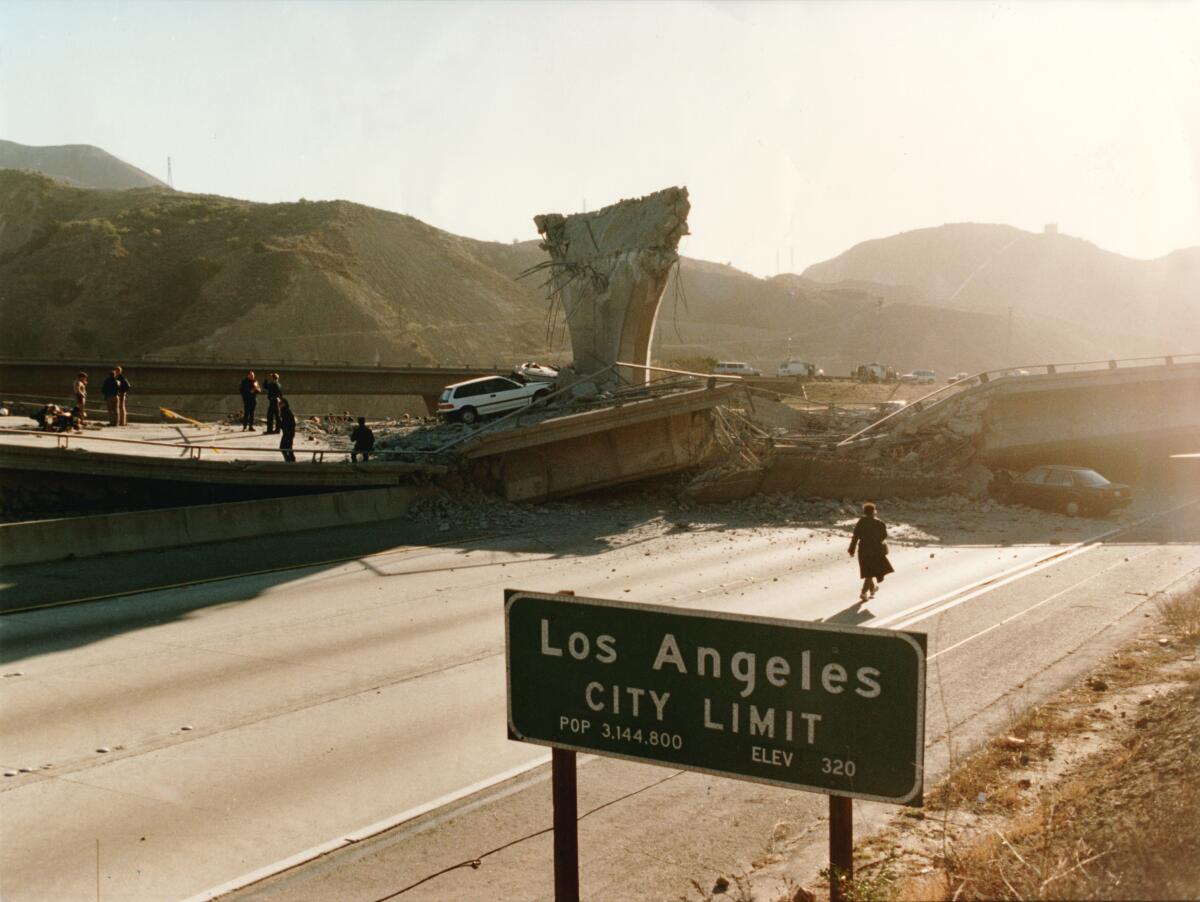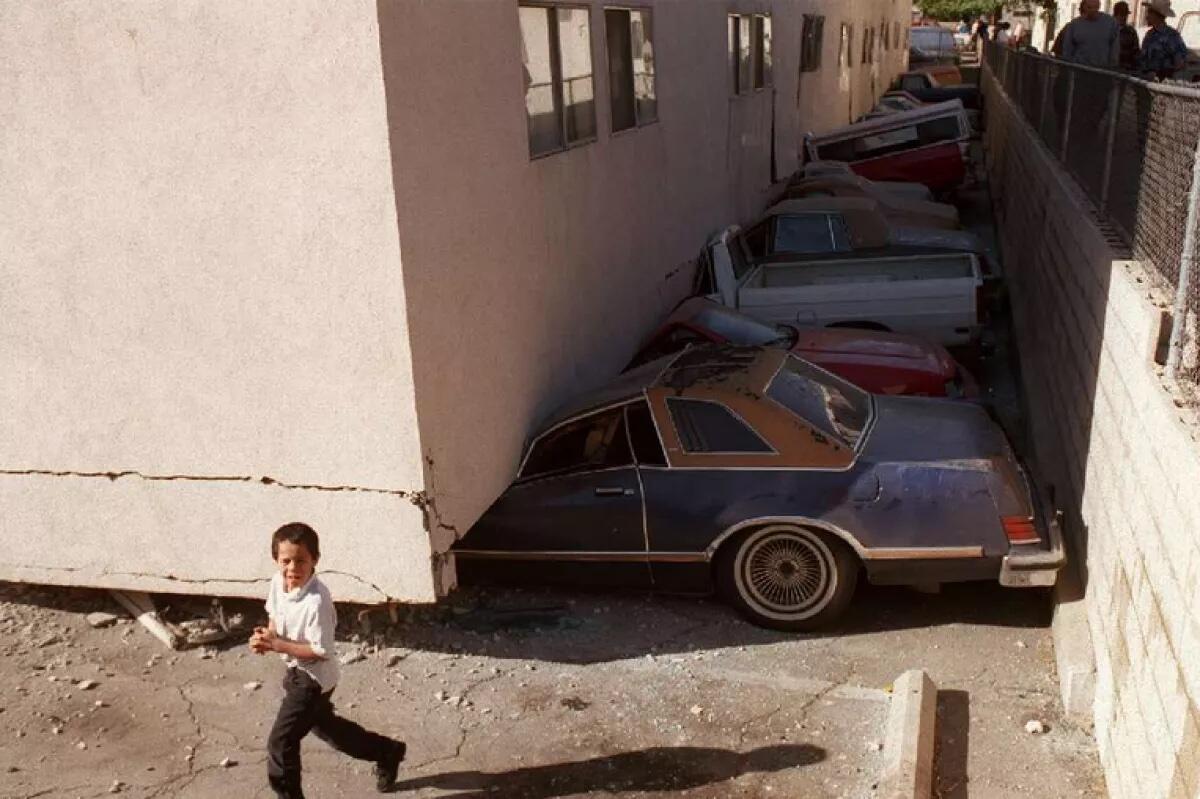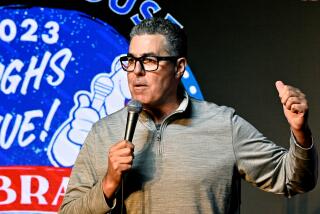Column: Our biggest threat might not be earthquakes or fires, but human nature

- Share via
If you buy into stereotypes and myths, the climate in Southern California is splendid and the people are laid back.
Lies.
The conditions are harsh, with crazy winds and parched terrain cooking up one calamity after another, and anyone who isn’t on edge is either in denial, sedated or a renter.
Until Jan. 7, when fires began to destroy thousands of buildings and claim at least 28 lives, my biggest fear about living in California was earthquakes, thanks to a 2017 trip to the San Andreas fault with Dr. Lucy Jones.
Steve Lopez
Steve Lopez is a California native who has been a Los Angeles Times columnist since 2001. He has won more than a dozen national journalism awards and is a four-time Pulitzer finalist.
I tagged along as Jones tried to convince two busloads of Southern California public officials that the Big One was coming, and they needed to update building codes and take other measures in anticipation of a historic catastrophe.
If a 7.8 struck, Jones and other seismologists said that day near Palm Springs, the ground beneath us would shift, and within 10 seconds, people standing face to face on opposite sides of the fault would be as much as 30 feet apart. As far away as Los Angeles, buildings would collapse, lives would be lost, the economy would be shaken, and millions of people would lose power and water for months.
I went home and hired a seismic safety engineer to fortify my house, and I’ve had earthquake insurance ever since. None of which gives you total peace of mind.

Last week, I bought a motorized pump with a 50-foot hose so I can use swimming pool water in the defense of my house during a fire. I did it after meeting a cop in Altadena who took me into his backyard and showed me his pump, which he had used, as embers fell, to protect his own home and those of his neighbors.
It took me three hours to force the hose onto the pump nozzle, but I couldn’t cinch it up securely. I have visions of being unable to get the motor started as flames approach, and when it finally catches, the hose flies off the pump and the gas tank explodes, taking out the entire block. Do I feel safe? Less safe?
To sleep well in Los Angeles, you can’t think about these things. You have to push away the reality of risk.
And that’s the real threat.
Human nature, in the end, is our Achilles heel.
I’m talking about denial, a convenient balm in a living laboratory of natural disaster. I’m talking about lack of preparation and planning, whether it’s having an earthquake kit at the ready or clearing brush.
California is not alone in this regard. Coastal Florida, for example, battered again and again by hurricanes, can’t wait to rebuild each time, just as close to the water as before. And as a nation, we downplay the role each of us plays in the link between climate change and calamity, while televising our national leader’s call to “Drill, baby, drill.”

Jones and I were talking about this complicated relationship between peril and the human psyche the other day, which she has studied for years, digging into “all the research on psychology and behavioral economics — on how people make decisions about risk.”
Too often, they decide not to decide.
Of all the cities that sent emissaries on that tour of the San Andreas fault in 2017, many have not yet acted on needed seismic safety upgrades. Jones estimated that about 6 million residents of Los Angeles County live where there are reasonable protections, and roughly 4 million do not.
Jones has not limited her public education campaigns to earthquakes. In 2023, the Dr. Lucy Jones Center for Science and Society produced a guide called “From Recovery to Resilience: Facing the Challenge of Increasing Wildland Fires in California.”
In it, she examined the dynamics of the Camp fire in Paradise, the Dixie fire in Greenville, the Bear fire in Butte County and the Woolsey fire in Ventura. The lessons were that communities have to act like communities before disaster strikes, consider the needs of the most vulnerable residents, and put the right people in charge.
“Emergency management is not just response,” Jones concluded in that report. “It is developing resilience before, responding efficiently during, and recovering quickly after a disaster.”
We’ve already learned, over the last two weeks, that we need improvements in each of those areas, despite the great work by so many firefighters and others.
Jones uses the letters WUI as shorthand for Wildland Urban Interface, which Los Angeles has by the thousands of acres, including in the Palisades and the base of the San Gabriel Mountains. Building in WUI locations can be safe if done properly, Jones said, but shouldn’t happen without “really thoughtful discussions … because our fire risk is up.”
Yes, the risk is so high after months of drought, those fires seem to be breaking out by the hour.
The thing about earthquakes, though, is that they don’t wait for Santa Ana winds or drought. That threat is constant.

“My worst nightmare is putting the two together,” Jones said. “Having an earthquake when we’re having Santa Anas.”
Now I’ll never sleep.
For a day or two in the early going, as the fires spread, I thought it might be time to pack it all in and move to a safer place. But I’m not sure if such a place exists in this world, and as the toll of the Eaton and Palisades fires mounted, I found myself becoming more deeply rooted.
The resilience Lucy Jones talks about and eloquently writes about — the DNA of community — was on display Jan. 8 at the Pasadena Convention Center, where evacuees summoned the strength to deal with loss and uncertainty while service organizations stepped up and volunteers pitched in.
My social worker friend who lost his home in Altadena after years of housing the homeless vowed through grief to re-create what he had lost, giving me a deeper sense of connection and humility. Anthony Ruffin had bought that house from his stepfather, who moved to western Altadena in 1972, when much of L.A. was off limits to Black people. He misses that house and the neighborhood and plans to rebuild in that very spot.
The selflessness of nursing home staffers who bravely evacuated patients, and the generosity of the Altadena family that shared the love of their home and neighborhood, all made me feel more attached to the real Southern California — the one that exists beyond myth and stereotype.
And to be attached is to be aware, to embrace responsibility to the land, to the planet, to survival, to each other.
More to Read
Sign up for Essential California
The most important California stories and recommendations in your inbox every morning.
You may occasionally receive promotional content from the Los Angeles Times.













